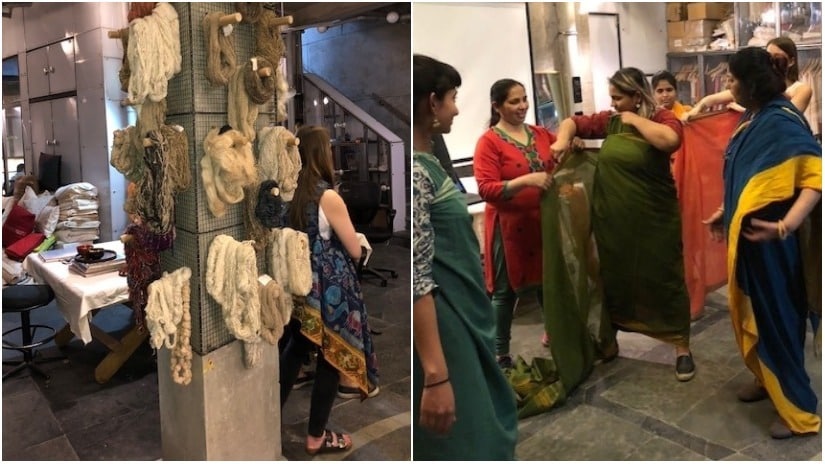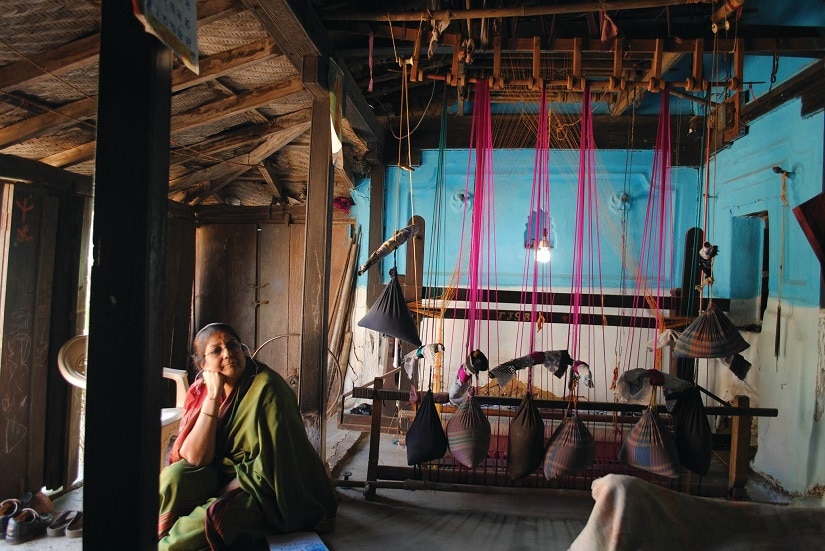Designer Sabyasachi Mukherjee’s recent comments about how Indian women who do not know how to drape a sari should ‘feel ashamed’ kicked up quite the row. While reactions tended to focus on ‘oh look, another man telling a woman what to wear’, it also brought up an interesting question — that of the relationship between an Indian woman and her sari. The sari has been fetishised, celebrated, overlooked, misunderstood (in perhaps equal measure), and our ties to it go back a long way. In this multi-part series, we take a look at the sari’s whole nine yards — its history and how different parts of the country embrace it; the sari as symbol; and the politics of the drape. Read on… The Sari School, as the name suggests, is for tutelage in yard upon unstitched yard of the sari. As the name doesn’t suggest, however, this is also a school with history, geography and cultural anthropology on its curricula. Founded by Rta Kapur Chishti in 2008, The Sari School conducts workshops at the textile scholar’s studio in New Delhi’s Jangpura Extension. The draping session that is underway is a series of choreographed movements of hand-spun cotton fabric around eager novices. A few instructions from Chishti and the sari is transformed into the Mohiniattam drape; she gesticulates swiftly, and the sari becomes a Dhokna Jalpaiguri from West Bengal; another gesture, and the Odissi fishtail style appears on the participants. Chishti’s last book, Saris of India: Tradition and Beyond, published in 2010 and co-authored by Martand Singh, enumerates a hundred and eight variations of draping the sari, “the most unique and versatile of garments.” Writes Chishti, in the introduction to the book, “Be it the vigour of working in the fields or squatting on the kitchen floor, it transforms itself according to need and function. In the manner of her carrying the sari, the wearer reveals her nature and demeanour. The bold and the shy, the silent but inquisitive, the athletic yet graceful, all manner of women hold their saris with characteristic ease, almost as if it were their second skin and not a textile extraneous to themselves.” [caption id=“attachment_4413227” align=“alignnone” width=“825”]  Rta Kapur Chishti conducts classes in sari draping at her workshop in New Delhi. Photo courtesy Radhika Oberoi[/caption] While the ancestries of the sari remain nebulous – Chishti describes it as “Draupadi’s unending fabric of time” – unsewn garments have been documented by historians on figurines from the Harappan and Mohenjo-daro civilisations. The bust of a bearded man, the ‘Priest King’ of Mohenjo-daro, reveals a shawl-like patterned garment draped over his shoulder, providing irrefutable proof that the Indian subcontinent’s dexterity with handloom weaving can be traced back to the Indus Valley Civilisation of the era 2800-1800 BC. Vedic literature provides definitions and descriptions of fine fabric and attire. Vijai Singh Katiyar enumerates a variety of fabric referred to in the Vedas, in his 2009 book, Indian Saris: Traditions-Perspectives-Design: “Clothes worn at that time were called paridhana or vastra. Fine fabric was called suksma-vastraor su-vastra. A new dress was called sei-vastra.” Also in this series: How the sari wove together Indira Gandhi's politics, Jayalalithaa's power and Mother Teresa's compassion The commonplace nivi style of wearing a sari, which represents a universal drape, also finds a mention in the Vedas. Sometimes attributed to a distinct Dravidian influence, the nivi drape is similar to the vesthis of southern Indian states. Katiyar elaborates in his book, “Brahminical injunctions in the Sanskrit literature refer to the lower garment, which was pleated and tucked at the navel in a style similar to vesthi or a dhoti. The parted or bifurcated manner of wearing a dhoti, as is still seen in North India, has come to be called kachcha style.” At The Sari School, Chishti is a veritable encyclopaedia of facts, both contemporary and historical. She mentions the use of Chinese silk in saris worn by Marwari women, “It is such high-twist silk that it doesn’t sit. The sari floats around them like a ship; Chinese silk is meant for Chinese dresses, you see.” She dwells on the difference between a sari and a fabric: “I beg to differ that a fabric can become a sari; it cannot! It isn’t just a length of fabric that you drape around yourself. It needs that difference in weight and texture to carry off a wearing style, otherwise it will look limp or sag or look dead or fluffy.” She rolls out a bit of fabric and says, “The shortest sari – meant for a five or six -year-old girl. It is four cubits long and one cubit wide.” The cubit, an ancient measure based on the length of a forearm, from the tip of the middle finger to the bottom of the elbow, is 18 inches (0.457 metres) in length. Chishti reveals that she now uses the four-cubit sari as a headscarf. [caption id=“attachment_4413235” align=“alignnone” width=“825”]  The different styles of sari draping that were demonstrated. Photo by Radhika Oberoi[/caption] The sari, pudava in Kerala, seere or bond in Karnataka, lugda or kapad or sado in Goa, jote or pata in Madhya Pradesh and Chhattisgarh, and bhaaj in West Bengal has as many regional variations in wearing styles, folding systems, inner end-pieces, and end fringes, as its colloquial names. Its prevalence in a particular region or community is often the result of a struggle for sartorial autonomy by a people bullied by the ruling classes to dress by decree. In Goa, for instance, the Portuguese had imposed a ban on sari weaving for over two hundred years, in order to promote the sale of imported fabric. Chishti, on one of her expeditions to the region in the 1980s, discovered 85-year-old Anton Juan Rasquinha in Akasai, Bardez. The old weaver had been weaving saris in a secret basement since 1916, when he had arrived in Goa from Mangalore with a Japanese automatic take-up motion handloom. “Starting with one only loom, he kept adding looms and weavers from the Kannara region. By 1960, there were 460 looms in the area, producing saris and shoulder cloths in clandestine basements,” writes Chishti. More from our sari series: Satyam Shivam Sundaram to Mr India, how the nine yards reflected Bollywood's favourite tropes [caption id=“attachment_4413259” align=“alignnone” width=“825”]  Rta Kapur Chisti. Image via Facebook[/caption] A chequered history and regional dissimilarities notwithstanding, the sari is perhaps the unendorsed national flag of the country, in an assortment of indigenous colours: neel, kumkum, baiguni, rani, and lambda. Passionate proponents of the unstitched fabric have also documented it in film. The Sari Series: An Anthology of Drape is a catalogue of over 80 short films that instruct the viewer in a variety of regional wearing styles. A non-profit project by multi-disciplinary agency Border&Fall, founded by Malika Verma Kashyap, the series, launched in October 2017, has also been supervised by Chishti. It is the first digital chronicle of drapes, and includes three exploratory films by filmmakers like Q (Qaushiq Mukherjee), Bon Duke, and Pooja Kaul. “We were keen to create a free and accessible resource of the drape,” says Kashyap, emphasising that this cultural documentation of draping methods is “with forward-looking aesthetics that attempt to bring about a change in perception – the sari is a contemporary garment, not just a traditional one.” As Goan poet and activist Balakrishna Bhagwant Borkar (Ba-ki-baab), writes, in a tremulous verse: Your braid decked in aboli flowers Flashes like lightening in the clouds Your purple blouse and sari are blood red earth. Whether blood red or turmeric yellow, checked or striped, flat-bordered or cross-ribbed, the sari and its one hundred and eight wearing styles represents this land, our land, its people, their many mutinies. Its warp and weft are the ties that bind and liberate – a paradox so effortlessly assimilated in nine yards of fabric.
The sari — pudava in Kerala, seere or bond in Karnataka, lugda or kapad or sado in Goa, jote or pata in Madhya Pradesh and Chhattisgarh, and bhaaj in West Bengal — has as many regional variations in wearing styles, folding systems, inner end-pieces, and end fringes, as its colloquial names
Advertisement
End of Article


)
)
)
)
)
)
)
)
)



